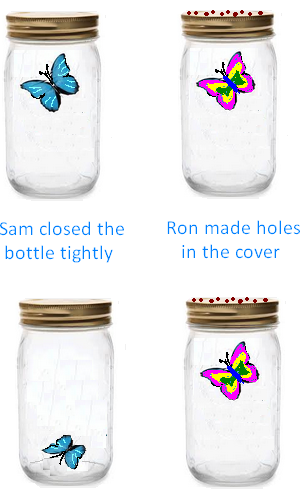Air and its Uses
Here we will learn about air and its uses. All living things need air. We know, air is all around us. We cannot see air but we can feel it. We cannot live without it.
When we breathe in, we use the oxygen in the air. When we breathe out, the carbon dioxide made in their bodies goes out into the air. We do this all the time.
One day, Sam and Ron caught two beautiful butterflies. They wanted to show these to their friends at school. The next morning they took their bottles to school.
They observe that Sam's butterfly is not alive since it did not get enough oxygen but Ron's butterfly is alive. From here we learnt that the air around us contains oxygen, carbon dioxide and water vapour. Along with this it also has dust, smoke and germs. It is polluted.
When a street is swept, the dust mixes with the air. Dust and smoke from factories mixes with the air. Smoke from cars, buses and trucks mixes with the air.
To avoid this, cars and buses should not give out smoke. They should be checked every month for this. Factories must be built far away from cities. Even there, they should not pollute the air with smoke.
Sick people cough or sneeze. Germs from their throat and nose mix with the air. We need to cover our face when we cough or sneeze.
After a shower of rain, the dust and the smoke in the air are washed out. Plants give out oxygen while making their food. They also give out water vapour. This keeps the air moist. Growing more trees is one way of keeping the air fresh and clean.
Air and its uses are very important for us to survive but we will be more healthy if we breathe fresh and clean air.
What does air contains?
Air contains tiny dust particles. Air carries dust when it moves. We can see dust in the air when a beam of light falls into a dark room. Air also has a number of very small living things. They cannot be seen and can harm. They are called germs.
Smoke coming out from vehicles, factories makes the air dirty. Dirty air is harmful for us.
Air has water vapour. In the sun water from seas, rivers and lakes, changes into water vapour. Water of wet clothes also changes into water vapour in the sun. Air has many gases.
What are the properties of air?
The properties of air are:
Air fills things: Blow air into a balloon. It becomes bigger as it is filled with air.
Air has weight: A football full of air is heavier than an empty football because of the air present in it.
Air is needed for burning: A candle burns when kept on a table as it gets air. When it is covered with a glass jar, it blows out, as there is no air.
Air is needed for breathing: Air keeps us alive. All plants and animals need air to breathe.
From where do we get fresh air?
We get fresh air from various places and its very good for our health.
Plants make the air fresh and clean. We know air and its uses so, we must grow more plants to get more fresh air.
Play in the open air.
Keep the windows open to let in fresh air.
Do not cover your face while sleeping.
Note: Impure air is bad for our health.
From Air and its Uses to HOME PAGE
Recent Articles
-
What Is Plasma? | Blood Plasma | Proteins | Nutrients | Cholesterol
Nov 07, 25 10:29 AM
Blood is a mobile fluid which is a connective tissue and is derived from the mesoderm like cell any other connective tissue. Colour of blood is reddish and that flows inside the blood vessels by means… -
Disorders of Respiratory System | Tuberculosis | Pleurisy | Emphysema
Oct 28, 25 11:39 PM
Tuberculosis is very common disease and is caused by a type of bacteria called Mycobacterium tuberculosis. This disease causes different trouble in the respiration and infection of several parts of th… -
Regulation of Respiration | Respiratory Centres | Inspiratory Area |
Oct 14, 25 12:13 AM
Respiratory Centre is the area that controls the rate of respiration and it is observed to be located in medulla oblongata and pons. Respiratory Centre has the following will dispersed components like… -
Explain Transport of Gases | External Respiration | Tissue Respiration
Oct 09, 25 11:35 PM
In humans gaseous exchange is completed in the following ways the steps are - External Respiration or Breathing - Breathing in false taking in of Oxygen and giving out of carbon dioxide in the body. M… -
Kind and Number of Teeth | Location of Teeth in Mouth | Care of Teeth
Sep 11, 25 12:52 AM
Kind and Number of Teeth






New! Comments
Have your say about what you just read! Leave me a comment in the box below.